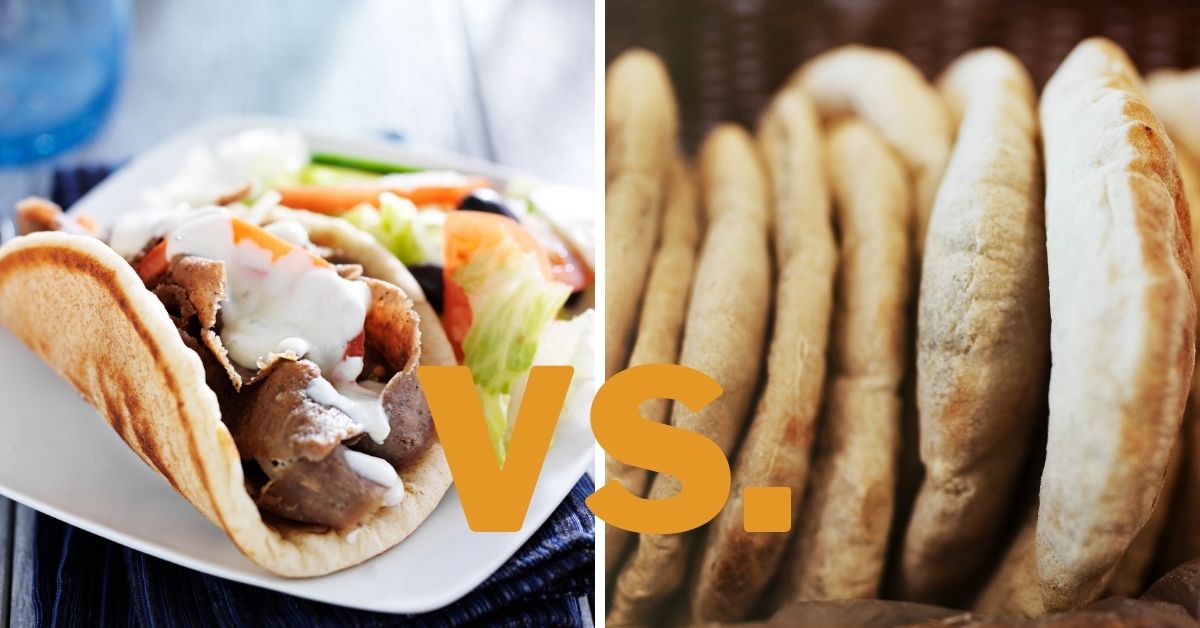Gyros vs. Pita: What Are the Differences?

With so many fast food items available these days, mixing traditional items with newer innovations, it can be easy to confuse the name of one food with another. This is especially true if the foods are related. And in the case of gyros and pita, you will often find them together on the same menu. But are they the same thing? What are the actual differences between gyros and pita?
Pita is a type of flatbread, while gyros is a meat dish that is frequently served inside or wrapped in a pita. So, pita is commonly used as a side item to enhance other food. But gyro is a whole dish on its own.
Gyros is a very popular Greek fast food item, while pita is one of the more common flatbreads. So, let’s take a closer look at these two items, discuss how they are made, and see just how they complement each other in a dish.
What Is the Difference Between Gyros and Pita?
Let’s take a closer look into the origins, ingredients, preparation, and popularity of gyros and pita.
Origin
Pita has been a staple of several Mediterranean and Middle Eastern cuisines for hundreds of years. The exact location of its origin is vague, but proof of its existence can be traced to the west of the Mediterranean.
Wheat, the key ingredient of most pita bread, is one of the earliest crops to be domesticated. So, it is no surprise that the roots of this flatbread date back to the stone ages, according to some archeological findings.
Gyros have their root in Greek culture, but the influence behind them has Turkish origins. The method of cooking meat on a vertical spit originated during the Ottoman Empire, in the region that is more or less modern-day Turkey. This method gave rise to various popular street food items such as doner kebab, shawarma, as well as gyros.
Since its inception, gyros has been a staple part of Greek cuisine and one of their most famous fast food items.
Ingredients
Similar to many other flatbreads, pita is made from wheat flour. Yeast is used as a leavening agent. Occasionally, a pinch of salt is also added to the dough to give it a bit of flavor.
The center part of any gyros recipe is meat, be it lamb, beef, pork, or chicken. This meat is frequently accompanied by pieces of vegetables such as sliced tomatoes, onions, potatoes, etc. The use of different spices is also a notable feature of making gyros.
Preparation
Traditionally, the meat in gyros is cut up into thin, flat slices and then piled on top of each other to form a stack. Then the stack is placed vertically on a rotisserie, which slowly spins and cooks the meat. Additional fat and seasoning such as cumin, thyme, rosemary, etc., are lathered on the meat to give it extra flavor.
Typically, most gyros dish in Greek cuisine utilizes pork, but chicken and lamb are also common. In America, gyros are made from using ground beef instead of the traditional thin slices.
After the meat is cooked, it is cut into thin slices and shaved off the large pile. The meat is then accompanied by other elements like vegetables (raw or cooked), cooked rice, French fries, and various sauces. Finally, the whole meal is wrapped in a flatbread, which varies based on the region you are in.
To make pita, you need to mix flour with water and yeast to form a dough. The dough is left for proofing for a relatively short time, usually around 10-15 minutes. This proofing period allows the yeast to ferment the flour and produce gasses. Then the dough is rolled into a flat sheet, the thickness of which will vary.
The pita is then baked at high temperatures, during which the water inside the dough turns into steam. This causes the pita to rise and forms a pocket between two layers of dough. When the pita is taken off the oven or stove, it deflates significantly. But the layers still remain, which allows for pockets to be formed when you cut or rip it open.
This pocket is a key feature in many pita recipes. This allows you to put fillings inside the pita such as meat, vegetables, sauce, etc. This is how pita is made and served in most Arabic and Middle Eastern cuisines.
However, there are many variations of pita that are pocketless. Greek pita is a very prominent example of a “pocketless pita”. This is also the pita that is commonly used to wrap the meat in a gyros dish.
Pita can also be fired to form a crispy texture, which is then served with a dip or sauce. It can also be cut into pieces and served alongside grilled meat and vegetables.
Popularity
Both pita and gyros are popular items in the world of fast food and street food. Pita is often the flatbread of choice when serving shawarma, souvlaki, burritos, gyros, etc.
Gyros have been a staple food in Greek cuisine for many years. And its popularity has crossed over to the West as well as Asian countries.
Gyros Vs. Pita: Which Is Better?
You really cannot decide a winner here as gyros and pita do not fall under the same category of dishes. Gyros is a proper meal on its own, while pita is mostly used to complement various dishes. Pita is actually a great choice for wrapping gyros, which is why they are often seen together in many recipes.
To sum up, pita and gyros are a wonderful pairing that is sure to take your taste buds on a pleasant experience. So, if you are in the mood for a meaty experience, give this combo a try. And the best part is that you can add so many variations to this core concept, giving it your signature twist on a classic dish.
